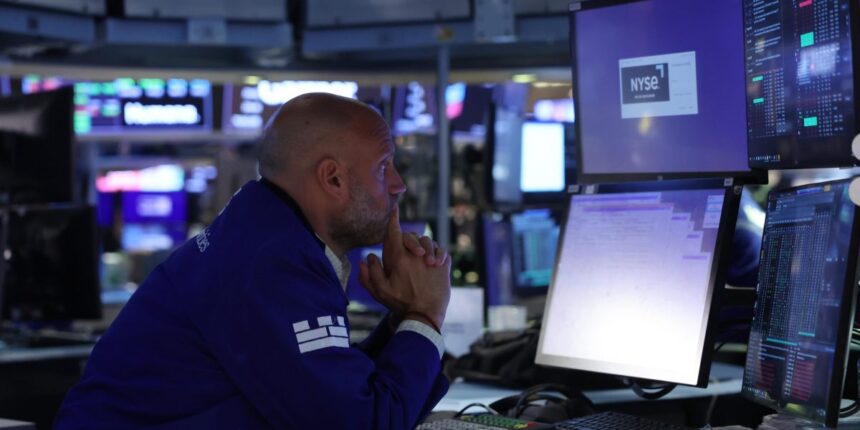
There’s clearly no shortage of hype surrounding the latest developments in artificial intelligence.
Ever since OpenAI’s ChatGPT chatbot rolled out to great fanfare in November, generative A.I. startups have raked in venture capital money like never before and stocks linked to the new technology have soared. But Edward Stanley, head of thematic research in Europe at Morgan Stanley, believes investors should be patient amid the “bubble-like euphoria.”
The veteran analyst and his colleague, Matias Ovrum, recently compared the current “excitement” surrounding A.I. with 70 market bubbles over the past century to determine how investors should play the theme.
The pair believe in the long-term potential of A.I. In fact, they argued in a research note on Monday that the technology will be “transformational across industries” and “one of the most prominent secular investment themes over the coming decade.” But given the run up in A.I.-linked equities this year—most notably chipmaker Nvidia, which has seen its stock soar nearly 200% year-to-date—Stanley and Ovrum don’t want to be “ignorant to the tactical debates” about elevated valuations and the legs of the current hype cycle.
Based on his research into past market bubbles, including the likes of the dot-com bubble and the post-COVID “everything bubble,” Stanley said that investors should be careful buying high-flying A.I.-linked stocks this year.
“History has shown that for multi-year themes – which we believe this is – there is usually little need for investors to rush in,” the veteran analyst wrote in emailed commentary to Fortune.
In the short-term, the A.I. hype is just a Keynesian beauty contest
When it comes to A.I.-linked stocks, Stanley warned, the short-term outlook might not be that bright based on historical evidence, even if the long-term potential of the underlying technology is clearly there.
“Hype around Search in the late 1990s, for example, was ultimately warranted. However, investors could have waited until 2003 to have a better understanding of who the likely winners would be and still capture >90% of the equity upside, and with greater downside protection,” he noted.
In their analysis of market bubbles over the past 100 years, Stanley and Ovrum found that the recent run-up in Nvidia and U.S. large cap tech stocks due to A.I. has been even more dramatic than average. “If we use NVIDIA or U.S. Large Cap Tech as the proxy – tactically this rally would be in its later-innings,” they warned.
In describing the recent market euphoria for A.I., the Morgan Stanley analysts pointed to the late British economist John Maynard Keynes’ beauty contest analogy.
Introduced in Chapter 12 of his 1936 book, The General Theory of Employment, Interest and Money, Keynes described a beauty contest held by a London newspaper in which participants were asked to pick the most beautiful woman from 100 photographs. The wrinkle to the game was this: Any voter who selected the most popular choice would be given a cash reward.
Keynes argued that most voters in this type of beauty contest wouldn’t pick the woman that they, personally, thought was the most beautiful. Instead, hoping to win some cash, they’d pick the woman who they believed the group of voters as a whole would choose as the most beautiful. Or, more sophisticated voters might even take things a step further and attempt to anticipate “what average opinion expects the average opinion to be,” he explained.
Keynes believed this type of herding behavior is often seen in markets and is one of the reasons bubbles form. Investors will purchase a stock based purely on their perception that other investors will buy the same stock, instead of any fundamental analysis. Morgan Stanley’s analysts argued this “annual beauty contest” is feeding into the current A.I. stock market boom.
The euphoric rise in A.I. stocks, coupled with a recent slowdown in “needle-moving A.I. product releases,” implies “some tactical caution on the theme by investors is warranted in the second half of the year,” Stanley told Fortune.
Over the long-term, it’s got potential
Investors certainly need to be careful over the short term when it comes to A.I.-linked stocks, but over the long term, it’s a different story. A.I. remains the decade’s top investing theme.
In his Monday research note, Stanley explained there are steady “signs of consumer and enterprise ‘stickiness’ versus prior hype cycles” and that user adoption of open-source A.I. models has been impressive.
At the leading repository of open-source A.I. models, Hugging Face, the top 100 models were downloaded 3.5 billion times since January 2021. “The breadth and depth of trial-and-error in trying to build the killer apps on top of these models is still in the exponential phase,” Stanley said of the data.
To determine the long-term potential of A.I.-linked stocks amid the development of A.I. tech, Stanley and Ovrum compared the past rise of bubbles to the much more modest year-to-date jump of A.I. indexes in 2023.
“Bubbles tend to rally a median 154% in the 3 years pre-peak; 217% on average. The first derivative A.I. winners have rallied over 200% YTD [year-to-date], yet broader A.I. indices are up a more modest 50% YTD [year-to-date] and not yet above prior 2021 highs,” they explained, arguing that “stickiness and breadth of diffusion set AI apart from prior hype cycles.”
Over the long-term, Stanley told Fortune that the more modest run up in A.I. stock indexes vs. past bubbles means that A.I. remains “one of the most attractive secular themes in the market”—investors just need to be careful when and where they put their money to work.








